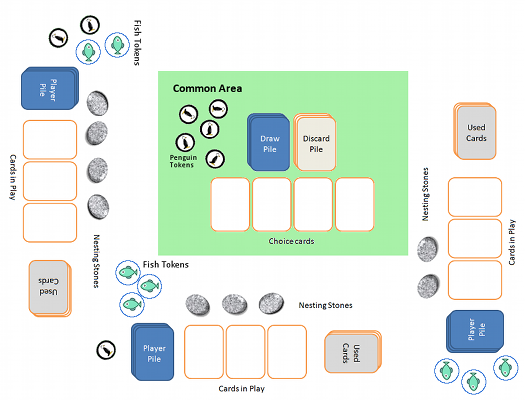June 2010 Game Design Showdown - "Slippery Slope"
Please Read: Details on entering the Game Design Showdown.
This Challenge is now OVER. Congratulations to this months winner, Gentoo, with 15 votes! Runners up are Alma Mater with 12 votes, and League of Artistic Wizards with 10 votes.
With 11 entries and 64 total votes I think this was a successful Showdown! I look forward to reading the critiques thread. Thanks for entering!
Main Design Requirements:
Design Consideration: Slippery Slope, but no Runaway Leader. An aspect which is usually considered a problem in game design is called the Slippery Slope. It's often a problem because it can easily lead to a Runaway Leader - someone who gets an early lead and is impossible to catch, therefore the remainder of the game is irrelevant. This months Showdown challenges you to use the Slippery Slope dynamic in your entry, WITHOUT allowing for a Runaway Leader to emerge. Here's a link to a pretty good article about this which may prove helpful. (In particular the section called "Limited Slippery Slope")
Mechanics Restriction: Deck Building.
The success of Dominion has sparked a lot of interest in an exciting "new" mechanism - Deck Building. This months Showdown challenges you to use some form of Deck Building in your entry. Please note that this does not mean your entry should be a Dominion clone! The more creative you are in your use of Deck Building as a mechanism, the more votes you're likely to receive!Theme Restriction: None.
There's no theme restriction this month. Use your imagination!Bonus: There is no bonus theme or mechanism this month.
- Submissions: Friday, 18-June-2010 through Sunday, 27-June-2010.
- Voting: Through Tuesday, 6-July-2010. I will be out of town so please bear with the wonky deadlines and give me a day or two to post entries/results - thanks!
Voting Format: Each person has 6 votes to distribute any way they choose among the GDS entries with the following restrictions: -
- You may not assign any votes to your own entry!
-
- You may not assign more than 3 votes to any single entry.
- You need not assign all 6 votes.
Comments or Questions: Comments and questions about this Challenge were handled on the Comments Thread.
- CRITIQUES: After voting has closed the entries will be posted for comments and critiques. Post constructive critiques and commentary about the entries to this Challenge in the Critiques Thread
- GDS Details: For more details on how these Game Design Showdown Challenges work, especially the details around the word count and graphics limits, visit the GDS Wiki Page.
Enjoy!
-Seth

















Tower of Babel
Playing time: 30 minutes
The Tower of Babel may be one of the most intriguing feats of early human civilization as described in various religious texts. Only the texts usually get it wrong. In the Bible, it is presented as having "its top in the heavens". In reality, the Babylonians were early astronomers, and many houses had "the heavens on its top" -a star chart inscribed on the roof. But I like the image of an ever expanding ziggurat, so let's build one!
Components
1 6-sided dice (used as a 'D3', i.e. all results are divided by 2 and rounded up.)
150 material tokens
- 40 Stones
- 30 Crates
- 50 Bricks
- 15 Ladders
- 15 Stools
Special tokens
- 10 Ropes
- 10 Mortar
Setup
20 Brick tokens and 10 Stone tokens are set aside for use during the game. Each player draw 6 tokens, which are kept hidden from your opponents.
Rules and gameplay
Building a tower
A tower must be started using at least 3 sections for the base level.
Each level above this must be at least 2 sections wide, but must contain 1 less section than the level below. (A ziggurat is a kind of pyramid after all).
Anytime during the game, a level can be expanded 1 section, as long as the one above is also expanded at the same time. Only 2 levels at a time can be expanded in this manner.
Using the tokens
Any token can be used on top of 2 other of the same kind.
A Stone can stand on the ground and on a Crate.
A Crate and a Brick can stand on anything but a Ladder and a Stool.
A Ladder can stand on anything but a Stool.
A Stool can only support other Stools.
The special tokens Rope and Mortar are used like this:
A Rope ties together Any number of Ladders or Stools on the same level, or 1 Ladder or Stool on the edges of two adjacent levels. They are then stable enough to be replaced by a Brick token.
In the same way, one Mortar token make two or more Bricks stable enough to be replaced by Stone tokens. The Stone still must have either another Stone or a Crate to stand on.
Playing the game
Using the starting hand, each player start building their tower on the table using the tokens available to him/her. Once everyone have finished building, one player throw the dice and the result is the number of tokens to draw in the next round.
If one player is alone in having the lowest tower after any round, s/he is only allowed to build 1 new level in this round.
Winning
The game ends the round that all players reach at least 5 levels.